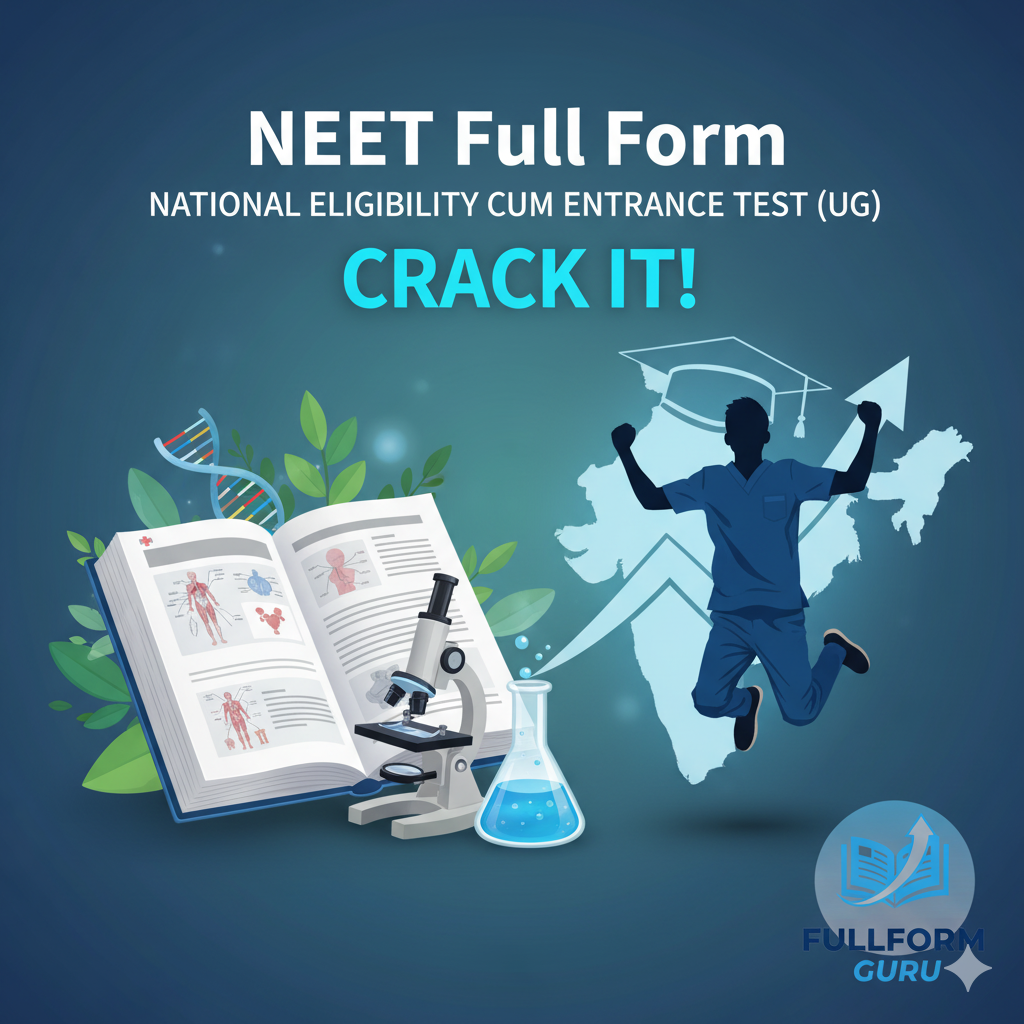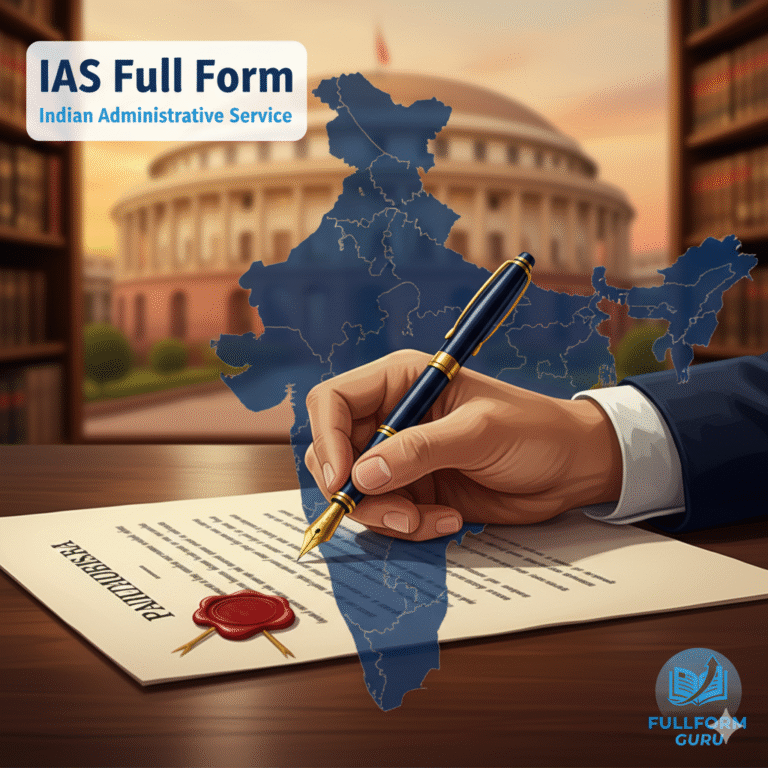NEET Full Form: Exam, Eligibility, Syllabus, and Career Opportunities

Introduction
Understanding the Full Form of NEET (National Eligibility cum Entrance Test) helps students realize the importance of this exam in shaping their medical careers. NEET, held at the national level, is the entrance exam for medical courses like MBBS, BDS, BAMS, and BHMS in India and is also accepted by many universities abroad. Every year, millions of aspirants compete for limited seats, making the exam highly competitive. Understanding the structure, eligibility, and purpose of NEET is the first step to successful preparation.
NEET Full Form and Meaning
The NEET Full Form is National Eligibility cum Entrance Test, a standardized medical entrance exam that ensures fairness and transparency in admissions. This exam secures a fair and transparent admission process by replacing multiple state and institutional medical entrance tests with a single national-level exam.
The primary aim of NEET is:
- To provide equal opportunities for all aspirants across the country.
- To establish a uniform benchmark for admission into medical and dental colleges.
- To maintain quality and transparency in the selection of future healthcare professionals.
Types of NEET
Depending on the academic stage, the NEET Full Form covers three exam categories—UG, PG, and SS—each serving a different level of medical education. Here are the main types:
- NEET-UG (Undergraduate)
- For students who have completed high school (Class 12 or equivalent).
- Grants admission to MBBS, BDS, BAMS, BHMS, and other undergraduate medical programs.
- NEET-PG (Postgraduate)
- For graduates who have completed an MBBS.
- Grants entry into MD, MS, and postgraduate diploma programs.
- NEET-SS (Super Specialty)
- For doctors who have completed postgraduate studies (MD/MS).
- Grants admission to DM/MCh super-specialty programs.
This classification makes NEET a complete gateway, from undergraduate entry to specialized medical expertise.

Eligibility Criteria for NEET
To appear for the exam mentioned under the NEET Full Form, candidates must meet defined eligibility standards related to age, subjects, and marks. These ensure that only students with the right academic background and qualifications can apply. The general criteria are:
- Educational Qualification:
- Candidates must have completed or be appearing in Class 12 (or equivalent) with Physics, Chemistry, Biology/Biotechnology, and English as core subjects.
- General category students must secure at least 50% marks in the PCB (Physics, Chemistry, and Biology) subjects.
- For reserved categories, the minimum percentage may be relaxed (e.g., 40–45%).
- Age Limit:
- The age of the candidate should not be less than 17 at the time of joining.
- The upper age limit may vary depending on policies, but generally, candidates up to 25–30 years are allowed, with relaxations for reserved categories.
- Number of Attempts:
- There is usually no fixed attempt limit, meaning candidates can apply as long as they meet the age and qualification criteria.
It ensures that NEET remains accessible to students worldwide while maintaining academic standards.
NEET Exam Pattern (Structure of the Exam)
The NEET represents a national-level exam that measures a student’s understanding of Physics, Chemistry, and Biology through a structured test pattern. It is conducted offline (pen-and-paper-based) and has a fixed duration of 3 hours and 20 minutes. The exam tests Physics, Chemistry, and Biology (Botany + Zoology), with Biology carrying the highest weightage.
Exam Overview
| Subject | Number of Questions (Attempted) | Marks |
| Physics | 50 (45 to be solved) | 180 |
| Chemistry | 50 (45 to be solved) | 180 |
| Biology (Botany + Zoology) | 100 (90 to be solved) | 360 |
| Total | 200 (180 attempted) | 720 |
Marking Scheme:
- +4 marks for every correct answer
- -1 mark for every wrong answer
- 0 marks for unanswered questions
Key Points
- Total questions: 200, with 180 required to attempt
- Type of questions: Multiple Choice Questions (MCQs)
- Focus: Heaviest weightage on Biology
- Purpose: To evaluate high school-level knowledge in a standardized manner
Understanding the NEET Full Form also means knowing how the exam pattern evaluates your preparation.
NEET Syllabus
The syllabus under the NEET primarily includes topics from Class 11 and 12 in Physics, Chemistry, and Biology, forming the foundation of medical knowledge. The syllabus focuses on Physics, Chemistry, and Biology, with Biology accounting for 50% of the total marks.
Subject-wise Breakdown
Physics
- Class 11: Motion, Laws of Motion, Gravitation, Work & Energy, Thermodynamics, Oscillations, Waves
- Class 12: Electrostatics, Current Electricity, Magnetism, Optics, Electromagnetic Waves, Modern Physics
Chemistry
- Class 11: Structure of Atom, Chemical Bonding, States of Matter, Thermodynamics, Equilibrium, Basics of Organic Chemistry
- Class 12: Solid State, Solutions, Electrochemistry, Chemical Kinetics, Surface Chemistry, p-block elements, Biomolecules
Biology
- Class 11: Subjects include Cell Biology, Human and Plant Physiology, Animal and Plant Structure, and the Diversity of Living Organisms
- Class 12: Genetics, Evolution, Ecology, Biotechnology, Human Reproduction, Reproductive Health

Key Takeaway
- Biology should be the top priority (50% weightage).
- Physics and Chemistry hold equal weight in achieving a balanced score.
- The syllabus is almost identical to high school science, so consistent revision and practice ensure readiness.
Who Should Consider NEET?
The NEET examination is ideal for individuals who aim to start a career in medical and healthcare-related professions. Here’s a clear breakdown:
| Type of Aspirant | Why NEET is Relevant |
| High School Students (Class 12 / Equivalent) | Essential to pursue MBBS, BDS, BAMS, BHMS, and other undergraduate medical courses. |
| Medical Graduates | Required for NEET-PG or NEET-SS to specialize in MD, MS, DM, or MCh programs. |
| Repeaters / Droppers | Those taking a gap year after Class 12 can focus on their preparation. |
| International Students / NRIs | Needed to gain admission to Indian medical colleges or recognized institutions abroad. |
| Alternative Career Aspirants | NEET scores are applicable for enrollment in BDS, BAMS, BHMS, and Veterinary Science studies. |
Key Points
- NEET is mandatory for anyone aiming to study medicine in India.
- Scores can also open doors to allied healthcare fields.
- Even if you don’t pursue MBBS, clearing NEET can be a gateway to other medical streams.
Hence, understanding the Full Form of NEET is essential for all medical aspirants.
Conclusion
The NEET Full Form (National Eligibility cum Entrance Test) is not only an entrance exam but also a symbol of dedication for students aspiring to build successful medical careers. With clear understanding, dedicated preparation, and consistent practice, aspirants can secure admission to top medical colleges in India and abroad.
Key Takeaways:
- Give priority to Biology, since it has the most marks.
- Maintain consistent study routines and solve previous years’ papers.
- Stay updated with exam patterns and eligibility requirements.
- Use NEET scores to explore allied medical courses if needed.
Remember, preparation + perseverance = success. Every hour you invest in studying brings you closer to your dream of becoming a doctor or medical professional. Start early, stay focused, and aim high—your efforts today will shape your medical career tomorrow.







